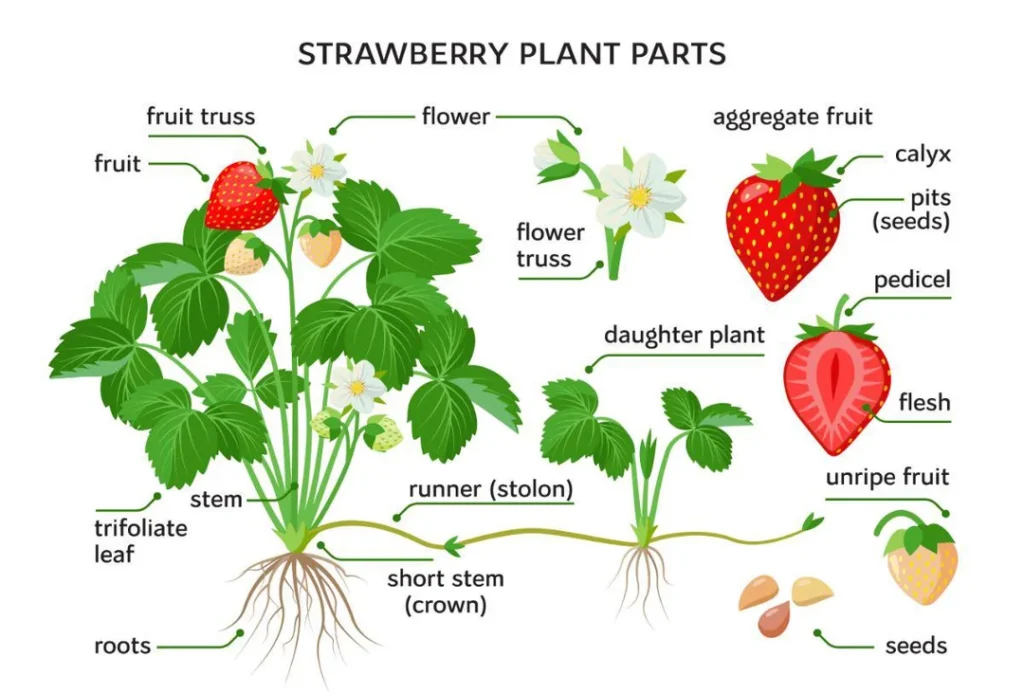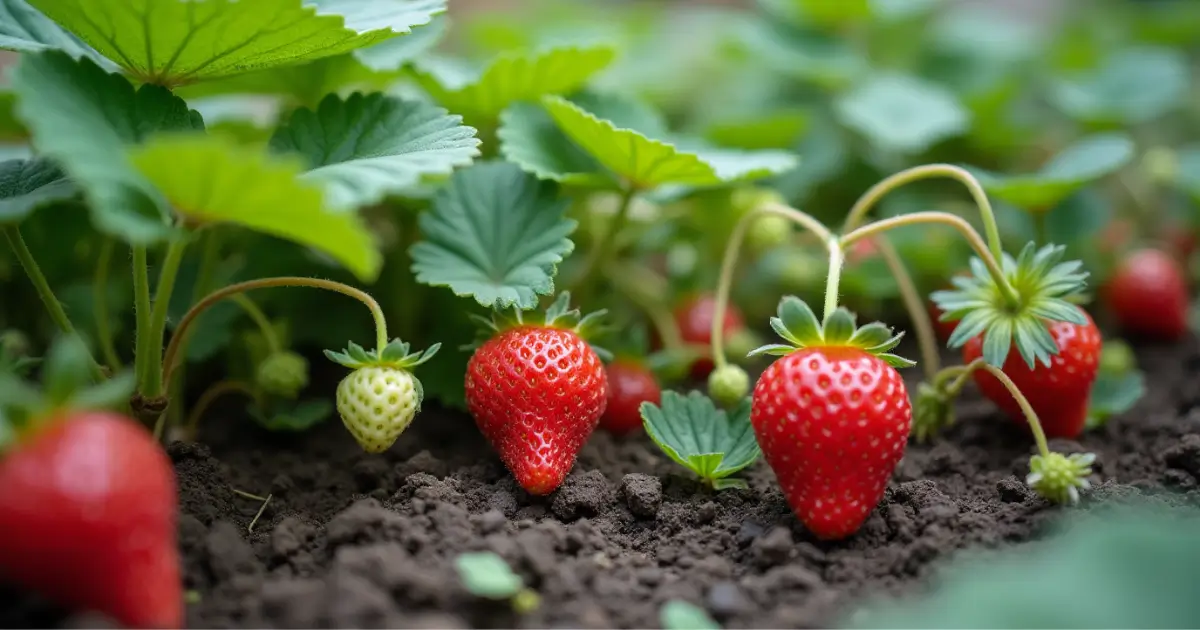7 Easy Steps for How to Grow Strawberries
1. Introduction : The Joy of Growing and Harvesting Strawberries
There’s nothing quite like harvesting fresh strawberries from your own garden. Sweet, juicy, and packed with flavor, strawberries are a rewarding fruit to grow. With Gardening From Home, you can successfully cultivate strawberries in your backyard, raised beds, or even containers on your balcony.
The best part ? Strawberries multiply ! Unlike most fruits that require replanting each season, strawberries grow from runners, which means once you start your garden, you can continue harvesting strawberries from existing plants year after year.
This guide will teach you how to grow, care for, and harvest strawberries while ensuring they keep producing for seasons to come. Whether you’re a beginner or an experienced gardener, Gardening From Home makes it easy to grow strawberries successfully !
Table of Contents
2. Understanding the Basics : Why Grow Strawberries with Gardening From Home ?
Strawberries are perennial plants, meaning they can produce fruit for several years when properly cared for. With the right approach, you can continue harvesting strawberries season after season from the same plants !
I. Benefits of Growing Strawberries at Home :
- Continuous Harvest – Strawberries send out runners that produce new plants, creating an ongoing supply.
- Fresh, Organic Fruit – No chemicals or pesticides, just natural, homegrown goodness.
- Cost-Effective – Once planted, they multiply, meaning no need to keep buying new plants.
- Space-Saving Options – Perfect for raised beds, vertical gardens, or hanging baskets.
II. Types of Strawberry Plants :
- June-Bearing – Produces one large harvest per season (best for big yields).
- Everbearing – Provides two or three smaller harvests throughout the year.
- Day-Neutral – Grows continuously, producing strawberries all season long.
💡 Tip : If you want a year-round strawberry harvest, plant a mix of June-bearing and Everbearing varieties !

3. Choosing the Right Plants for Continuous Harvesting :
Since strawberries reproduce naturally, selecting the right variety and planting strategy will maximize your long-term yield.
I. Best Strawberry Varieties for Home Gardens :
- Albion – Sweet, disease-resistant, and perfect for containers.
- Seascape – Great for warmer climates, producing fruit all year.
- Quinault – An everbearing variety that works well in hanging baskets.
II. Seeds vs. Runners : How to Start Your Strawberry Garden :
- Seeds – Cheaper but take longer to grow (6+ months before fruiting).
- Seedlings (Young Plants) – Ideal for beginners, ready to fruit quickly.
- Runners – These are natural offshoots from parent plants that grow into new plants, allowing you to expand your garden without buying more strawberries!
💡 Tip : Start with seedlings for a quick harvest, then use runners to grow more plants for free !
Image Description: A comparison of strawberry seeds, seedlings, and runners, with arrows showing how each develops into a fruit-bearing plant.
4. Planting Guide & Setup : Step-by-Step Instructions :
I. Best Time to Plant Strawberries :
- Spring and fall are ideal for planting.
- Soil should be around 60°F to 80°F for best growth.
II. How to Plant Strawberries from Runners :
- Choose a healthy mother plant with strong growth.
- Locate a runner (long stem) that has tiny roots forming.
- Press the runner into the soil and cover the roots lightly.
- Keep it attached to the parent plant until it establishes roots.
- Once rooted, cut the runner, and you have a brand-new strawberry plant!
💡 Tip : Use runners strategically—plant them in new areas to expand your strawberry garden without spending a dime.

5. Essential Care & Maintenance for a Thriving Strawberry Patch :
I. Watering :
- Water 1-1.5 inches per week to keep soil moist but not soggy.
- Avoid overhead watering to prevent mold and fungal diseases.
II. Fertilizing : Boosting Strawberry Growth Naturally :
Fertilizing your strawberry plants is essential for strong roots, healthy leaves, and a bountiful harvest. Whether you prefer organic or store-bought fertilizers, the right nutrients will maximize fruit production and ensure your plants thrive.
When to Fertilize Strawberries :
- At Planting – Helps young plants establish strong roots.
- After Flowering Begins – Boosts fruit development.
- Mid-Season – Maintains plant health for continuous harvests.
💡 Tip : Avoid over-fertilizing—too much nitrogen leads to large leaves but fewer strawberries!
Best Natural Fertilizers for Strawberries :
If you prefer organic gardening, several natural fertilizers provide the essential nutrients strawberries need. These eco-friendly options enrich the soil, improve plant health, and support sustainable gardening.
Compost – The All-Purpose Superfood :
Why Use It ?
- Provides balanced nutrients (nitrogen, phosphorus, potassium).
- Improves soil structure and drainage.
- Feeds beneficial microbes in the soil.
How to Apply ?
- Mix well-aged compost into the soil before planting.
- Apply a thin layer (1-2 inches) around the base of plants every 4-6 weeks.
💡 Tip : Compost made from vegetable scraps, coffee grounds, and eggshells is perfect for strawberries !
Coffee Grounds – A Natural Nitrogen Booster :
Why Use It ?
- Adds nitrogen, essential for leafy growth.
- Slightly acidifies the soil, which strawberries love!
- Improves soil aeration and moisture retention.
How to Apply ?
- Sprinkle used coffee grounds around the base of the plants.
- Mix lightly into the topsoil to prevent mold growth.
💡 Tip: Avoid overuse—too much can make the soil overly acidic!
Banana Peel Tea – Potassium-Rich Fertilizer :
Why Use It ?
- Packed with potassium, which enhances fruit quality.
- Contains phosphorus, essential for strong root development.
- 100% organic and easy to make at home.
How to Apply ?
- Chop banana peels into small pieces.
- Soak in water for 24-48 hours.
- Use the nutrient-rich water to water your strawberry plants.
💡 Tip : Bury small banana peel pieces near plant roots for slow-release fertilization !
Eggshell Powder – Calcium for Stronger Plants :
Why Use It ?
- Strengthens cell walls, preventing diseases like blossom-end rot.
- Helps maintain a balanced soil pH.
- Improves root development and plant structure.
How to Apply ?
- Dry and crush eggshells into a fine powder.
- Sprinkle around the base of the strawberry plants.
- Work it into the topsoil to enhance calcium absorption.
💡 Tip : Use eggshells alongside compost for a full range of nutrients !
Fish Emulsion – A Nutrient-Dense Liquid Fertilizer :
Why Use It ?
- Provides fast-absorbing nitrogen, phosphorus, and potassium.
- Supports lush foliage and strong root growth.
- Encourages more flowers, leading to higher fruit production.
How to Apply ?
- Dilute fish emulsion with water (follow package instructions).
- Apply every 2-3 weeks during the growing season.
💡 Tip : Fish emulsion has a strong smell but works wonders for plant growth !
How to Apply Natural Fertilizers for Maximum Yield :
| Fertilizer Type | Nutrients Provided | Best Time to Apply | Application Method |
|---|---|---|---|
| Compost | Nitrogen, Phosphorus, Potassium | Before planting, every 4-6 weeks | Mix into soil, apply around base |
| Coffee Grounds | Nitrogen | Every 2-3 weeks | Sprinkle lightly on soil |
| Banana Peel Tea | Potassium, Phosphorus | During fruiting stage | Water plants with banana tea |
| Eggshell Powder | Calcium | Monthly | Crush and mix into soil |
| Fish Emulsion | Nitrogen, Phosphorus, Potassium | Every 2-3 weeks | Dilute with water, apply as a liquid |
💡 Tip : Rotate between fertilizers to provide a balanced mix of nutrients for your strawberry plants !
Final Thoughts on Fertilizing Strawberries :
Fertilizing strawberries with natural, organic ingredients ensures strong, productive plants while keeping your garden eco-friendly. Whether you use compost, coffee grounds, banana peels, eggshells, or fish emulsion, these natural fertilizers provide everything your strawberries need to thrive.
🌱 Experiment with different fertilizers and see what works best for your strawberries! Let me know in the comments—what’s your favorite way to fertilize your garden ?
III. Pruning & Runner Management :
- Trim excess runners to focus energy on fruit production.
- Leave a few runners to propagate new plants.
6. Harvesting & Maximizing Your Strawberry Yield :
I. When and How to Harvest Strawberries :
- Pick strawberries when fully red—no white or green patches.
- Harvest in the morning for the best flavor.
II. Preserving Your Harvest :
- Store fresh strawberries in the fridge for 3-7 days.
- Freeze for long-term storage.
III. Encouraging Bigger Harvests :
- Remove old leaves to allow sunlight to reach developing fruit.
- Rotate crops every 3 years to prevent soil depletion.
💡 Tip : The more strawberries you harvest, the more the plant produces !

7. Final Thoughts & Call to Action :
Strawberries are the gift that keeps on giving ! By following these Gardening From Home methods, you can grow delicious strawberries year after year without replanting.
🌱 Ready to start your own strawberry garden ? Let me know in the comments if you have any questions !

8. FAQs :
1. How to grow strawberries at home without a big garden ?
You can grow strawberries in containers, hanging baskets, or vertical planters. They just need 6–8 hours of sunlight daily and well-drained soil.
2. What’s the best time to plant strawberries ?
Spring and fall are ideal. Plant when soil temperatures are between 60°F and 80°F for the best root development.
3. Can I grow strawberries from store-bought fruit?
No, store-bought strawberries usually don’t produce reliable seeds. For best results, use nursery-bought seedlings or runners from healthy plants.
4. How long does it take to grow strawberries from seedlings?
Seedlings take about 4 to 6 weeks to start producing fruit under proper care, while seeds may take 6+ months to mature.
5. How to grow strawberries so they keep producing every year?
Use runner propagation! Strawberries send out runners that turn into new plants. Trim some and replant them to expand your patch naturally.
6. What type of soil is best for growing strawberries?
Strawberries love loamy, well-drained soil with a pH between 5.5 and 6.8. Mix in compost to boost nutrients naturally.
7. How often should I water strawberry plants?
Water deeply 1–2 times a week, aiming for 1–1.5 inches of water total. Keep the soil moist but avoid overwatering.
8. How can I make my strawberries sweeter?
For sweeter fruit, grow in full sun, avoid over-fertilizing with nitrogen, and use natural methods like banana peel tea and compost to enrich the soil.

